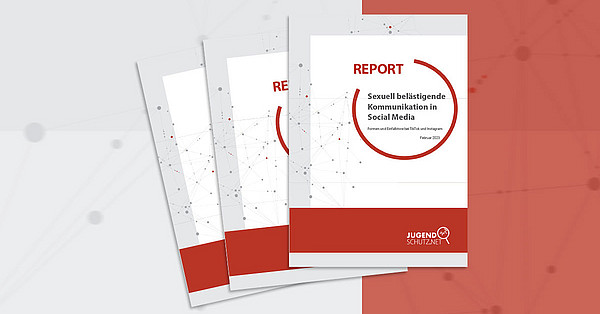Report from jugendschutz.netSexual harassment of children on social media

Posts, LIVES or Stories - TikTok and Instagram offer different ways to present oneself and interact with other users. A research by jugendschutz.net on these two platforms shows that children and young people experience sexual harassment themselves or are confronted with sexual harassment by other users.
Sexual harassment is defined by jugendschutz.net as "one-sided and unwanted sexual communication, which usually occurs abruptly and seems inappropriate. For children and young people, harassment of this kind can be detrimental to their development or even seriously harmful to minors.
Examples of sexually harassing communication from the report:
- Insinuation of sexual interest, e.g., "I think you're sexy" to a child.
- Sexualized or ambiguous speech without explicit terms, e.g., "mine is 13.5 cm."
- Showing sexual interest through explicit graphic, degrading language or depictions.
- Thematizing sexual fetishes, e.g., "I want to lick your feet."
- Asking for sex encounters.
- Unsolicited sending of sexual content.
Sexually Harassing Comments on TikTok LIVEs and Instagram
At TikTok , jugendschutz.net observed sexually harassing communication especially in livestreams of minors. Although the LIVE function is only available for users over 16 years of age and with at least 1,000 followers, there are also clearly younger users presenting themselves time and again. In addition to sexualized comments, there were specific requests to take off their clothes or participate in sexualized challenges. (Note: Since November 2022, live streaming on TikTok is only possible for users who say they are older than 18).
On Instagram, especially creators with an affinity for children and young people were affected by sexually harassing communication during the research. Sexual harassment can be found there especially among the posted contributions. This means that underage users come into contact with inappropriate text content without being directly addressed themselves.
Sexual content via direct messages represents a dark area. Direct messages play a major role on both Instagram and TikTok. It is assumed that this function is frequently used to enter into sexualized contact with children and young people.
The complete research by jugendschutz.net as well as information on how the services reacted to reported content can be found here:
How can I protect children from sexual harassment?
- Make security settings: The platforms TikTok and Instagram examined by jugendschutz.net offer protective mechanisms to prevent or make sexual harassment more difficult. However, these only work if the accounts are set correctly. Truthful information about the date of birth plays a major role here. This is because the security settings of the accounts vary depending on the age of the users. We have compiled further information on the security settings in the topics on Instagram and TikTok.
- Use the report, delete and block function: The report by jugendschutz.net states that both TikTok and Instagram offer a reporting system that is "accessible and easy to use at any time." Children and young people should be made aware of boundary violations so that they can recognize them. And they should know about the reporting and blocking functions of the services so they can use them. Information on these functions is available at saferinternet.at in theprivacy guides on Instagram and TikTok.
- Be a confidant: Children and young people need confidants who can provide help and advice when problems arise. To this end, it is necessary to take an interest in children's online activities and to engage in a regular exchange. In the case of sensitive topics such as sexual harassment, it can also be useful if children and young people can seek help and advice anonymously and without obligation. It therefore makes sense to familiarize children with offers of help at an early stage. In our topic area on cybergrooming, we have many offers of help for children and their relatives. listed.
